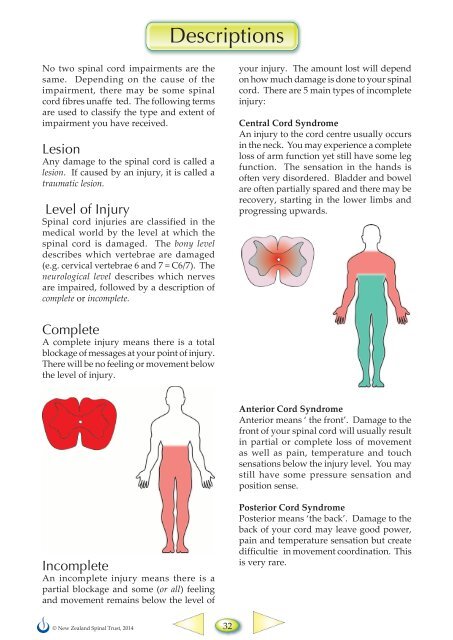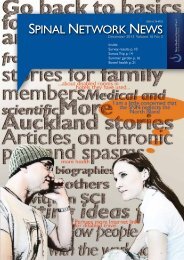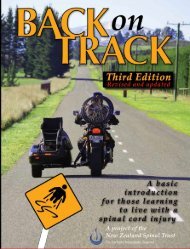o_19m515s4j1asl13rsiok91e166nh.pdf
Create successful ePaper yourself
Turn your PDF publications into a flip-book with our unique Google optimized e-Paper software.
Descriptions<br />
No two spinal cord impairments are the<br />
same. Depending on the cause of the<br />
impairment, there may be some spinal<br />
cord fibres unaffe ted. The following terms<br />
are used to classify the type and extent of<br />
impairment you have received.<br />
Lesion<br />
Any damage to the spinal cord is called a<br />
lesion. If caused by an injury, it is called a<br />
traumatic lesion.<br />
Level of Injury<br />
Spinal cord injuries are classified in the<br />
medical world by the level at which the<br />
spinal cord is damaged. The bony level<br />
describes which vertebrae are damaged<br />
(e.g. cervical vertebrae 6 and 7 = C6/7). The<br />
neurological level describes which nerves<br />
are impaired, followed by a description of<br />
complete or incomplete.<br />
your injury. The amount lost will depend<br />
on how much damage is done to your spinal<br />
cord. There are 5 main types of incomplete<br />
injury:<br />
Central Cord Syndrome<br />
An injury to the cord centre usually occurs<br />
in the neck. You may experience a complete<br />
loss of arm function yet still have some leg<br />
function. The sensation in the hands is<br />
often very disordered. Bladder and bowel<br />
are often partially spared and there may be<br />
recovery, starting in the lower limbs and<br />
progressing upwards.<br />
Complete<br />
A complete injury means there is a total<br />
blockage of messages at your point of injury.<br />
There will be no feeling or movement below<br />
the level of injury.<br />
Anterior Cord Syndrome<br />
Anterior means ‘ the front’. Damage to the<br />
front of your spinal cord will usually result<br />
in partial or complete loss of movement<br />
as well as pain, temperature and touch<br />
sensations below the injury level. You may<br />
still have some pressure sensation and<br />
position sense.<br />
Incomplete<br />
An incomplete injury means there is a<br />
partial blockage and some (or all) feeling<br />
and movement remains below the level of<br />
Posterior Cord Syndrome<br />
Posterior means ‘the back’. Damage to the<br />
back of your cord may leave good power,<br />
pain and temperature sensation but create<br />
difficultie in movement coordination. This<br />
is very rare.<br />
© New Zealand Spinal Trust, 2014<br />
32
















